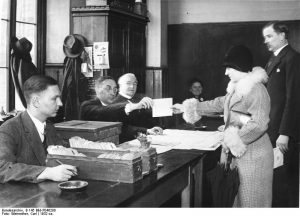Jewish women activists succeeded in their struggle for female voting rights just over 100 years ago in the Weimar Republic…
One major legal reform of the Weimar Republic consisted in its progressive electoral law, which gave women the right to vote at the age of 20. Germany’s law enabling female suffrage came into effect on November 30, 1918. Women were therefore allowed to participate in the first elections of the Weimar Republic in January 1919. Female voter turnout exceeded 80%. Around 300 women stood for election and 37 women won a seat in the 423-member National Assembly. On February 19, 1919, representative Marie Juchacz from the Social Democratic Party (SPD) took the floor: “This is the first time that in Germany a woman has been allowed to address the people in parliament on free and equal terms. What this government has done was self-evident; it gave women something that they have been wrongfully deprived of until now.”
This was a milestone in women’s struggle for equality. About one third of the leading German women’s rights activists were of Jewish origin. One of the most prominent of them was Tony Sender (1885-1964). Born to orthodox parents in Biebrich in the Rhineland, she referred to herself as a “dissident” already in her teenage years. In 1917, she was among the founding members of the USPD, the Independent Social Democratic Party in Germany, which had split off from the SPD. In 1920, Sender was elected to the German Reichstag (first as a representative of the USPD and then, after the parties’ reunification in 1922, of the SPD), holding office until January 1933. She became one of the most outspoken parliamentary opponents of National Socialism. On March 5, 1933, she fled Germany for the United States.

Still a Man’s world
Wikimedia / Bundesarchiv, B 145 Bild-P046280 / Weinrother, Carl / CC-BY-SA 3.0 / https://creativecommons.org/licenses/by-sa/3.0/de/deed.de
In German Jewry, the introduction of women’s suffrage triggered a controversial debate about Jewish women’s right to vote – and in some cases even to stand for election – in their congregations. In general, women had been barred from membership in a congregation or in religious associations during the Kaiserreich. In spring 1919, writer Else Dormitzer (1877-1958) published her “Demands of the Jewish Woman”, asking for the participation of women in all Jewish community affairs. Dormitzer played a key role in rallying women to become active members of the Central-Verein, the Central Association of German Citizens of Jewish Faith. In 1922, she was the first woman elected to the administrative board of the Jewish Community of Nuremberg which numbered about 10,000 members.
While the predominantly liberal Israelitische Kultusgemeinde of Munich granted women the right to vote in community elections and also to run for office as early as 1919, the Jewish communities in Prussia had little means to advance the cause of Jewish women. Due to Prussia’s Jewish Community Law of 1847, only men could stand for community elections. The government considered the promulgation of equal membership rights in the course of a revision of the 1847 law, but such a new constitution of the Jewish communities in Prussia was never completed.
In 1924, the Liberal Jewish party of Hamburg threw its support behind a Jewish Women’s Voting Rights Week organized by the League of Jewish Women. In the same year, in accordance with the Prussian Ministry of the Interior and despite the existing legislation, the Jewish Community of Berlin granted voting rights to women, and in 1926, four women won their seats on the board of representatives, among them Bianka Hamburger (1877-1942). “I can claim that women have earned themselves their right to vote in community elections, and that we have achieved this through peaceful means,” she said in 1926.
Many of the pioneering Jewish women in Weimar Germany were leaders in both Jewish communal politics as well as of political parties on the local level, for example Paula Ollendorff (1860-1938). A teacher by profession, she represented the German Democratic Party (DDP) in the Breslau municipality from 1918, thus being the first woman in Germany to hold the office of city councilor. In 1920, Ollendorff had become President of Germany’s Jewish Women’s League, an organization of 60,000 members, and in 1936 Vice President of the International Jewish Women’s Federation. From 1926 to 1936, she served as Executive Board Member of the World Union for Progressive Judaism. However, her voice was gradually silenced. At the September 1928 women’s meeting of the DDP, Paula Ollendorff summarized party attitudes towards female candidates which applied also to attitudes within the wider Jewish community: When newly enfranchised, women were courted, but with the rising dominance of special interests, “Male party leaders … sacrificed women first.” Four years later, with the demise of German Jewry ahead, another women’s rights activist, Käte Frankenthal, realized: “I fit in every category abhorred by the Nazis: Jewess, socialist, rabble-rouser, emancipated woman.”
